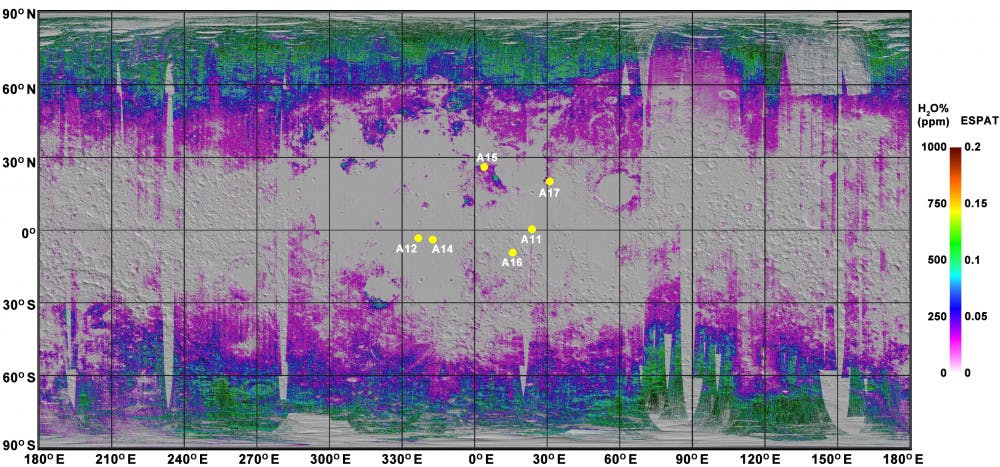Many people are unaware that water exists on the moon, but University scientists have gone far beyond corroborating this fact: They created a quantitative map of it. In a recent study, researchers used technology called the Moon Mineralogy Mapper to analyze not only the location of water on the moon, but also the sources, amount and reason it’s there in the first place.
According to Ralph Milliken, associate professor of earth, environmental and planetary sciences and one of the authors of the study, the research conducted for this project builds on two previous papers: one published in 2008 that analyzed samples from the moon and found water within “glass beads” that formed during volcanic eruptions while the moon itself was taking shape, and one from 2009 that found evidence of water on the moon’s surface.
The next step was to map the moon. The team analyzed strips of data collected by the Moon Mineralogy Mapper, which orbited the moon from 2008 to 2009, according to Shuai Li, a postdoctoral researcher at the University of Hawaii and one of the authors of the study. The researchers specifically looked at the signatures of reflected sunlight in the data. Different sorts of molecules reflect sunlight in different ways, which means that water can be distinguished from the rest of the lunar surface, Milliken said. The researchers analyzed the signatures at three microns; anything that was visible from that perspective had to be water, Li added. Afterward, they were able to combine all of the points to create their map.
Milliken and Li both differentiated between the two sources of water they analyzed on the moon.
One type of water comes from within the moon and exists inside “glass beads.”
But solar wind bombardment is the primary source of water on the lunar surface, said Alice Stephant, a postdoctoral research associate at the Open University.
Water forms when solar winds cause protons — which are essentially hydrogen atoms — to bombard the surface of the moon, creating hydroxyl atoms, Milliken said. Data from current technology cannot differentiate between hydroxyl and water, so the samples on the moon could be just hydroxyl or a combination of water and hydroxyl, he added.
The paper also focused on the volcanic deposits on the moon, indicating that some of the water must have come from inside the moon’s interior, said John Mustard, professor of earth, environmental and planetary sciences and one of the authors of the 2009 study.
Li and Milliken’s map contained a number of key discoveries. Many researchers had assumed water only exists at the poles, but the map showed that it exists across the lunar surface and increases from the equator to the poles, Li said. It was previously thought that there is more water in the brighter regions of the moon than in the darker regions, but the study revealed that the distribution may be more or less the same. Regions around the glass deposits were also found to be very dry, while the deposits themselves are comparatively wet, Milliken said. Still, the moon is very dry. To collect around a liter and a half of water, one would have to process about 100 to 300 cubic feet of lunar soil, he said.
Yet the study shows that the moon is much wetter than scientists had previously thought, according to Mustard.
Milliken said that he would like to see more data, namely lunar samples, from future studies concerning water on the moon. These could answer some questions that are still unanswered, such as whether water exists on the moon along with hydroxyl. Some spacecraft that were not intended to examine the moon but looked anyway have suggested that there is indeed water on the moon. But from a physics perspective, water should be too unstable on the surface of the moon, which can heat up to over 100 degrees celsius. Further data could substantiate or invalidate claims that there is water along with hydroxyl on the moon, and answer questions of how it could exist there, Milliken added.
Analyzing more samples could also provide insight into the distribution of water on the lunar surface, Mustard said. It is not fully known where water on the earth originated, and the collection of further samples could help answer this question, he added.
The extent of water on the lunar surface is not completely known, said Bonnie Buratti, a planetary astronomer at the Jet Propulsion Laboratory in Pasadena, California. But it is a “hint of greater things.”





